Your root cellar needs proper ventilation to keep produce fresh with ideal 95% humidity while preventing spoilage. You'll find seven effective methods to achieve this: basic dual vent setups with floor-level intake and ceiling exhaust, earth tube cooling systems using buried PVC pipes, natural air draft techniques utilizing opposite-wall placement, spinning turbine vents for continuous airflow, fan-powered systems with smart controls, traditional ground-level air holes with adjustable covers, and humidity-controlled ventilation management. Each method helps maintain excellent temperature and moisture levels while removing harmful ethylene gas. Let's explore how these proven solutions can transform your root cellar storage.
Basic Dual Vent Setup
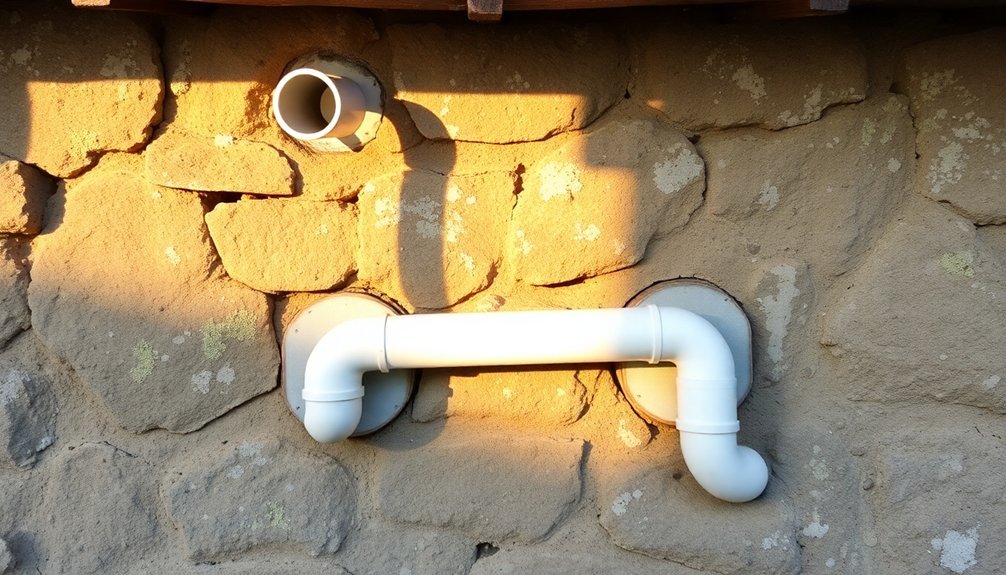
A properly designed dual-vent system forms the backbone of effective root cellar ventilation. You'll need two strategically placed vents: an inlet vent near the floor and an outlet vent close to the ceiling. This setup takes advantage of natural air movement, as cool air sinks and warm air rises, creating a consistent flow through your cellar. Regular airflow monitoring ensures proper temperature and humidity control throughout your storage space.
Install your inlet vent at ground level, allowing it to drop down and enter the cellar near the floor. Place the outlet vent on the opposite side of the space, positioning it high up near the ceiling. For best results, extend the outlet vent above ground level to enhance air movement.
If you can't install a vertical ventilation system through the roof, you can use horizontal vents on opposing walls.
You'll want to cover both vents with mesh screens to keep pests out while maintaining airflow. Seal around the vents using materials like expanding foam or rubber gaskets to prevent air leaks.
Remember to keep your vents open during cooler periods, especially at night, and adjust them seasonally – closed in winter and open in summer – to maintain ideal temperature control.
Earth Tube Cooling System
Earth tube cooling systems effectively harness the earth's stable temperature to naturally regulate your root cellar's climate. You'll need to bury PVC pipes 8-10 feet underground, placing them 30-40 feet away from your cellar. The system works through natural convection, with cool air entering through a lower inlet pipe and warm air exiting through an upper outlet pipe. Installing multiple smaller inlets can significantly improve the overall airflow performance of your system.
| Feature | Benefit |
|---|---|
| Underground Placement | Maintains 41-65°F year-round |
| Natural Convection | No electricity or fans needed |
| Condensation Management | Prevents moisture buildup |
You'll experience temperature drops of 10-20 degrees Fahrenheit, depending on your local conditions and building efficiency. The system's design promotes continuous air circulation, which removes ethylene gas and unwanted odors from your stored produce. It's particularly effective when combined with a turbine vent on your roof to enhance air movement.
The best part? Your earth tube system won't require significant maintenance for 25+ years. Just guarantee proper drainage around your cellar and include small drainage holes in the tubes' bottoms to manage condensation. The system works well in both humid and arid climates, making it a versatile solution for long-term food storage.
Natural Air Draft Methods
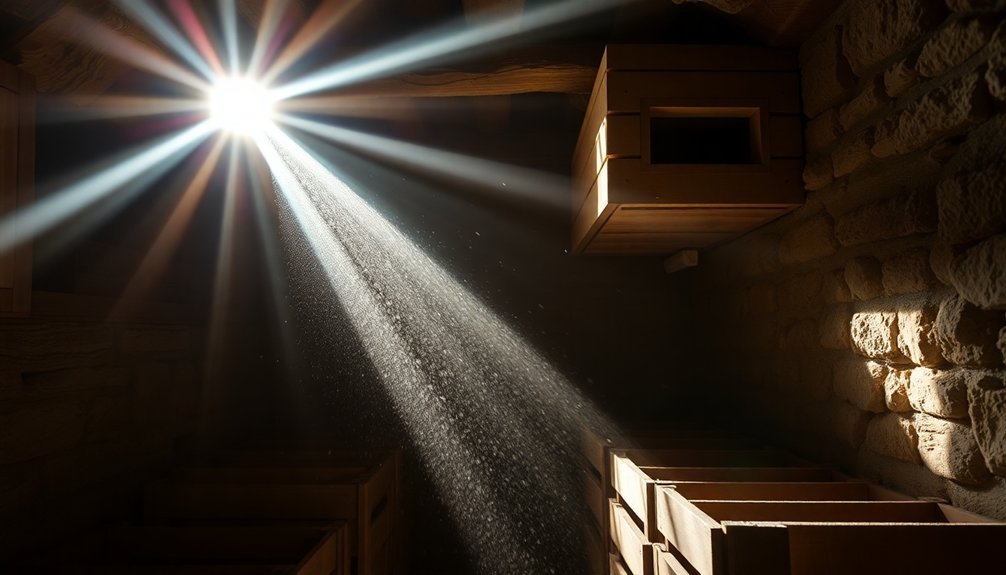
Natural air draft ventilation provides one of the simplest yet most effective ways to maintain your root cellar's environment.
You'll achieve the best results by positioning your vents on opposite sides of the cellar, with the inlet vent near the floor and the outlet vent high on the opposite wall or through the ceiling.
This setup creates a natural flow where cool air enters through the lower vent while warm air rises and exits through the upper vent.
For maximum efficiency, you'll want to extend your outlet vent pipe above ground level, which enhances the draft effect and improves air exhaustion.
To maintain ideal conditions, you'll need to monitor humidity levels between 60-80%.
Your ventilation system helps control this by reducing excess moisture when it's too damp and allowing you to add humidity when conditions are too dry.
You can adjust airflow by partially opening or closing vents, and you'll find a humidistat helpful for monitoring conditions.
Don't forget to leave gaps between your shelves and walls for proper air circulation.
It's also smart to open your vents at night when the air is coolest, and regularly check that they're free from debris.
Remember to screen all vent pipes and windows to prevent unwanted pests from entering your storage space.
Turbine Vent Installation
Proper installation of a turbine vent can greatly boost your root cellar's ventilation efficiency. You'll want to mount the vent at your roof's highest point, guaranteeing it's positioned to catch prevailing winds while remaining unobstructed by trees or structures.
Choose a 3-4 inch diameter turbine vent made from rust-resistant materials, and don't forget to include adjustable louvers for better airflow control.
For ideal ventilation, you'll need to create a complete system by pairing your turbine vent with floor-level intake vents. Install these on opposite sides of your cellar to maximize air circulation and effectively remove stale air and ethylene gas.
Add protective screens to keep out unwanted pests and debris.
To guarantee your turbine vent functions effectively year-round:
- Check and clean the vent regularly to prevent blockages
- Secure all components tightly to withstand severe weather
- Install weather-resistant flashing around the vent opening
- Cover vents during extreme cold to prevent freezing
Remember to take into account noise levels if your root cellar is near living spaces, and maintain accessibility for routine maintenance.
With proper installation and care, your turbine vent will provide reliable ventilation for your stored produce.
Fan-Powered Ventilation Systems
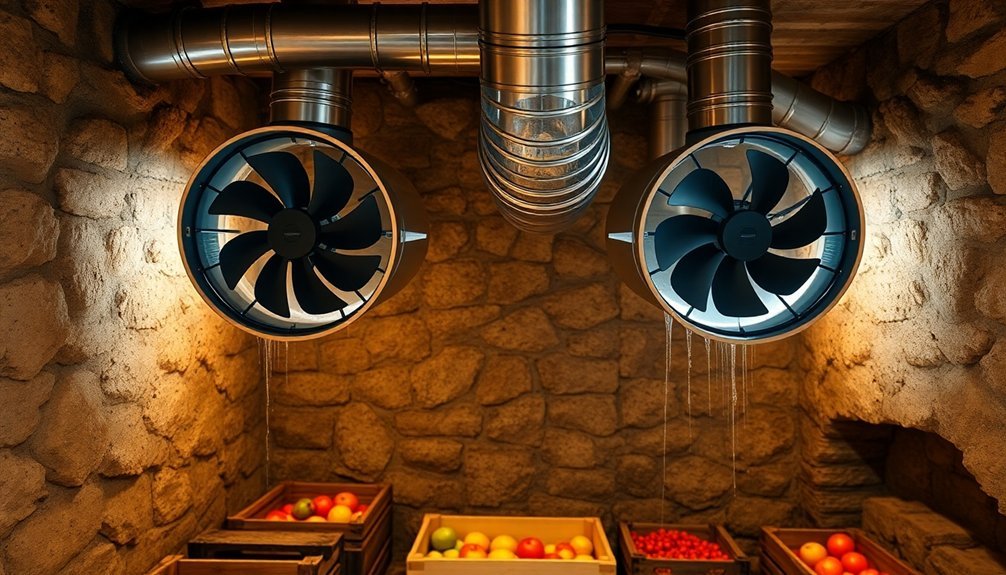
Position your ventilation fans strategically in the exhaust vents near the ceiling, where they'll effectively remove warm air and ethylene gas while promoting natural airflow throughout your root cellar.
You can control your fan system with smart switches or timers, running them during cooler periods to maximize efficiency and maintain ideal storage conditions.
Mount the fans securely using brackets, and connect them to low-voltage power sources like 12v DC adapters for reliable, energy-efficient operation.
Optimal Fan Placement Tips
When setting up fans in your root cellar, strategic placement is essential for maintaining ideal airflow.
You'll want to position your exhaust fan near the ceiling where it can effectively remove rising warm air and ethylene gas. For the intake fan, install it close to the floor on the opposite wall to draw in cooler air, creating a natural circulation pattern that works with, not against, the passive airflow dynamics.
For maximum fan placement and performance, follow these key steps:
- Mount your exhaust fan 6-8 inches below the ceiling, angled slightly upward to help direct warm air out through the 3-4 inch diameter vent.
- Install the intake fan near floor level, positioning it to draw air across your storage area before it rises.
- Keep fans at least 12 inches away from corners to prevent dead spots and guarantee proper air movement.
- Place fans opposite each other to create a diagonal airflow pattern across your cellar.
Remember to choose energy-efficient models that won't create excessive air pressure.
Your fans should complement the natural airflow while providing just enough power to maintain consistent air movement around your wire racks and properly spaced shelving units.
Control Systems For Airflow
Three core components make up an effective root cellar control system: ventilation design, fan automation, and monitoring equipment.
You'll need to install dual ventilation with intake and exhaust vents on opposite sides of your cellar. Place intake vents near the floor and exhaust vents near the ceiling to maximize natural air circulation. In cold climates, use insulated materials for your vents to prevent freezing, and make certain they're adjustable to control airflow based on outside temperatures.
To enhance airflow, install small electric fans in your exhaust vents and connect them to a smart control system. You can use microcontrollers like ESP8266 to read temperature and humidity sensors and automate fan operation. Connect these to smart switches that control ultrasonic misters for humidity management.
Using PVC Schedule 20 pipes works well for fan-powered ventilation systems.
Your monitoring setup should include sensors that track temperature, humidity, and air quality. Present this data on a local network webpage for remote monitoring.
Don't forget to elevate your storage crates to allow air circulation underneath, and make certain all system components remain accessible for maintenance and adjustments.
Traditional Ground-Level Air Holes
Traditional ground-level air holes have proven effective for centuries, relying on basic convection principles to maintain your root cellar's temperature and humidity.
You'll need to carefully consider both the size and quantity of air holes, typically 4-6 inches in diameter, to guarantee proper airflow without compromising the cellar's stable environment.
To maximize ventilation efficiency, you should position these holes on opposite sides of your cellar – intake holes near ground level where cool air enters, and outlet holes higher up where warm air escapes.
Historical Methods Still Work
Root cellars from out of the past continue to demonstrate the effectiveness of simple ventilation solutions. By placing intake vents low to the ground and exhaust vents near the ceiling, you'll create a natural flow of air that maintains suitable storage conditions for your produce.
This time-tested approach takes advantage of the basic principle that warm air rises while cool air falls.
You'll find that traditional designs work best when you follow these key installation points:
- Install ground-level intake vents on the north side where cooler air enters
- Position ceiling vents on the opposite wall to release warm air and ethylene gas
- Add a layer of gravel over packed earth flooring to balance moisture retention
- Include sealable vent covers to adjust airflow based on seasonal needs
Your root cellar's ventilation system will help maintain temperatures between 32-40°F (0-4°C) and humidity levels of 90-95%.
When you elevate storage crates off the floor, you're allowing air to circulate underneath, which prevents moisture buildup and mold growth.
The earth's natural insulation, combined with proper drainage around your cellar, creates ideal conditions for long-term produce storage.
Proper Hole Size Matters
Sizing ventilation holes correctly can make or break your root cellar's performance. You'll need two 3-4 inch diameter vent pipes, which work perfectly for root cellars up to 6×8 feet. Four-inch PVC pipes are your best bet for most installations, providing adequate airflow while preventing excessive temperature fluctuations.
Install one vent near the ceiling for exhaust and another near the floor for intake. They should be on opposite walls when possible, but you can place them side by side if necessary. Always angle the pipes downward to keep rain and snow out while maintaining proper airflow.
| Vent Feature | Purpose | Critical Specs |
|---|---|---|
| Diameter | Air Volume | 3-4 inches |
| Upper Placement | Exhaust | Near ceiling |
| Lower Placement | Intake | Near floor |
| Screen Mesh | Pest Control | 1/4 inch holes |
| Angle | Weather Protection | 15-30 degrees |
Don't forget to cover vent openings with mesh screens to keep rodents out. You'll want to check these vents regularly to verify they're clear of debris and functioning properly. This ventilation system works with natural convection, as warm air rises and exits through the upper vent while cool air enters through the lower one.
Strategic Air Hole Placement
A cellar's ventilation success depends heavily on the strategic placement of ground-level air holes. You'll want to position your intake vents near the floor on exterior walls, while placing outlet vents high up near the ceiling. This setup takes advantage of natural convection, as cool air is heavier than warm air, creating an efficient flow through your storage space.
To maximize your root cellar's ventilation efficiency, follow these key placement steps:
- Install intake vents on the north-facing wall when possible, keeping them close to ground level.
- Position outlet vents on the opposite wall at ceiling height to create cross-ventilation.
- Place vents away from areas prone to water accumulation to prevent moisture issues.
- Include adjustable covers on all vents for seasonal control.
If you're building into a hillside, you can use the earth's natural insulation to your advantage.
Make certain you've got proper drainage around your cellar to prevent waterlogged soil from freezing. You'll also want to guarantee there's adequate space beneath your storage crates for air to circulate effectively.
Installing a small exhaust fan can enhance airflow when natural convection isn't sufficient.
Humidity-Controlled Airflow Management
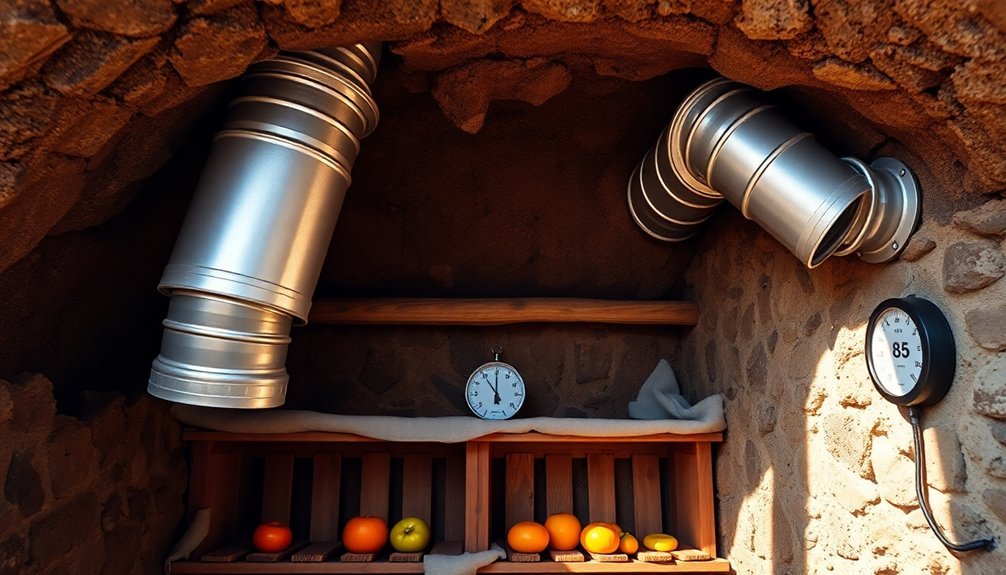
Managing humidity levels through proper airflow is essential for a successful root cellar storage system.
You'll need to maintain 90-95% humidity while preventing excess moisture buildup that can lead to mold and spoilage. Your dirt or gravel floor will naturally release moisture, but you can supplement humidity by sprinkling water on the floor or hanging damp burlap bags.
To control humidity effectively, you'll want to create consistent air circulation using your ventilation system.
Install wire racks on your shelves and leave space between storage areas to allow air to flow freely around your produce. If you're in a particularly dry climate, you can place pans of water in strategic locations, but monitor them carefully to prevent pest problems.
You'll need to check your ventilation regularly and adjust it based on changing conditions.
During winter, you can seal your vents to maintain temperature, while summer requires open vents for increased airflow. If you notice condensation forming on the ceiling, treat it with a disinfectant to prevent disease.
Remember to keep your cellar dark and consider adding small electric fans to your exhaust vents if natural airflow isn't sufficient.
Frequently Asked Questions
How Often Should Ventilation Filters Be Cleaned or Replaced?
You'll need to inspect your ventilation filters every 3-6 months and clean or replace them when you notice visible dirt buildup. If you've got pets or allergies, you should check them more frequently.
Can Root Cellar Ventilation Systems Be Adapted for Different Climate Zones?
Yes, you'll need to adapt your cellar's ventilation based on your climate zone. In warm areas, increase airflow and cooling, while in cold regions, focus on insulation and controlled venting to maintain ideal storage conditions.
What Emergency Backup Options Exist if Mechanical Ventilation Systems Fail?
You can rely on portable fans, open emergency vents, or move produce to cool basements. It's smart to keep battery-operated fans ready and maintain alternate storage areas as backups if your main system fails.
How Do You Prevent Small Animals From Entering Through Ventilation Openings?
You'll need to install fine mesh screens and hardware cloth over vent openings, secure them tightly, and seal any gaps. Regular inspections and cleaning will guarantee your screens stay effective at blocking unwanted critters.
What Are Signs That Indicate Insufficient Airflow in a Root Cellar?
You'll notice high humidity, condensation on walls, mold growth, musty smells, inconsistent temperatures, and premature produce spoilage. Your vegetables may develop strange odors or rot faster than they should when airflow's insufficient.
In Summary
You've now got the knowledge to properly ventilate your root cellar using these seven proven methods. Whether you choose the simple dual vent setup or opt for a more advanced earth tube system, proper airflow is essential for keeping your produce fresh. Remember to monitor temperature and humidity levels regularly, and don't hesitate to combine different ventilation techniques for best results in your specific storage situation.

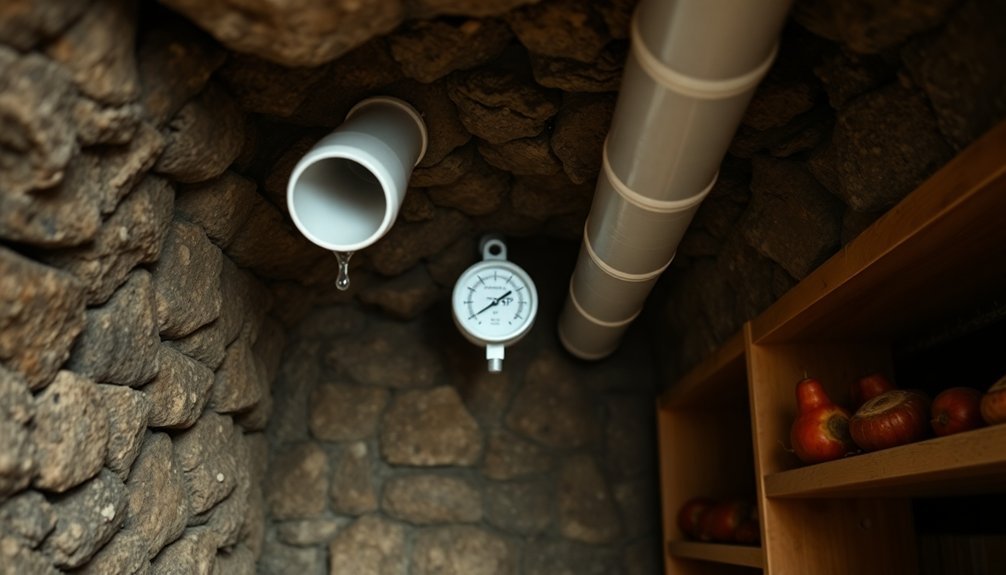



Leave a Reply